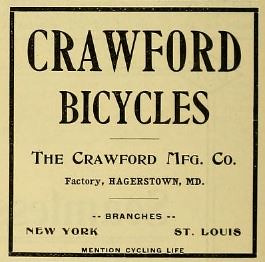
Title-Ride a Crawford Bicycle
Summary-Young couple with bicycles pause by side of road.
Created / Published-1896.
Notes
- Chromolithograph by Strobridge & Co. Lith., Cincinnati-New York, 211 x 102 cm.
- This record contains unverified, old data from caption card. Medium-1 print (poster).
Call Number/Physical Location POS - ADV. 19th c. - Bicycles. S778, no. 7 (in 3 parts) (D size) [P&P]
Repository-Library of Congress Prints and Photographs Division Washington, D.C. 20540 USA
www.loc.gov/item/2002719169/
The summer of 1896 was the height of the "bicycle craze" of the 1890s - a price range of $60 to $75 at that time was fairly good (that is, inexpensive) compared to Columbia bicycles that were offering their most expansive models for $100.
"For Health & Recreation" is an amusing slogan to feature on this poster, given that the couple seems mostly to be enjoying one another's company. Also, the width of the byway upon which they are traveling seems fanciful - not realistic one suspects for the time (or any time, in fact). Still, cyclists were (ahead of motorists, who didn't yet exist!) leaders in the "good roads" movement. Well - some cyclists along with some bicycle manufacturing companies. There had to be some good roads in order for the product to be useful.

A modest ad for Crawford Bicycles - see how it appeared here: archive.org/stream/cyclinglife00test#page/n759/mode/1up in "Cycling Life," a trade journal. This small ad ran frequently in 1896-1897.
Crawford Bicycles had its factory in nearby Hagerstown MD. (Nearby from the perspective of the Washington DC area.) In 1902 the Crawford brothers sold their bicycle business to a larger bicycle company and proceeded to start up an automobicle manufacturing company, Crawford Automobile.





![Crippled German soldier [on bicycle] (LOC)](https://farm1.staticflickr.com/577/22211914854_348b929476.jpg)




